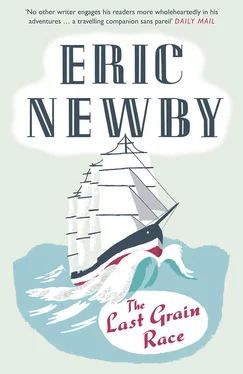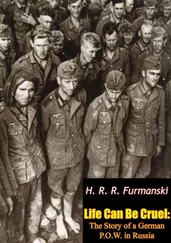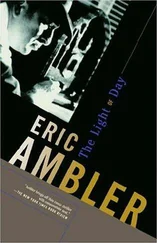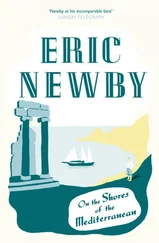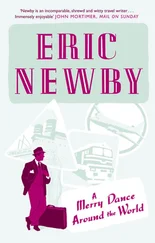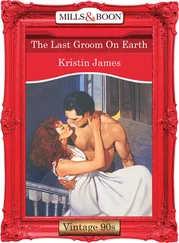1 ...6 7 8 10 11 12 ...16 ‘Change your shoes? Op the rigging.’ He was becoming impatient.
At this time Moshulu was the greatest sailing ship in commission, and probably the tallest. Her main mast cap was 198 feet above the keel. I started towards the main rigging on the starboard side nearest the quay but was brought back by a cry from the Mate.
‘Babord, port side. If you fall you may fall in the dock. When we’re at sea you will always use the weather rigging, that’s the side from which the wind blows. Never the lee rigging. And when I give you an order you repeat it.’
‘Op the rigging,’ I said.
The first part of the climb seemed easy enough. The lower main shrouds supporting the mast were of heavy wire made from plough steel and the first five ratlines were iron bars seized across four shrouds to make a kind of ladder which several men could climb at once. Above them the ratlines were wooden bars seized to the two centre shrouds only, the space for the feet becoming narrower as they converged at the ‘top’, eighty feet up, where it was difficult to insert a foot as large as mine in the ratlines at all. Before reaching this point, however, I came abreast of the main yard. It was of tapered steel, ninety-five and a half feet from arm to arm, two and a half feet in diameter at the centre and weighed over five tons. It was trussed to the mainmast by an iron axle and preventer chain which allowed it to be swung horizontally from side to side by means of tackle to the yardarms; an operation known as ‘bracing’.
Above me was the ‘top’, a roughly semi-circular platform with gratings in it. This was braced to the mast by steel struts called futtock shrouds. To get to the ‘top’ I had to climb outwards on the rope ratlines seized to the futtock shrouds. There was a hole in the ‘top’ which it was considered unsporting to use. I only did so once for the experience and cut my ear badly on a sharp projection which was probably put there as a deterrent. I found difficulty in reaching the top this first time and remained transfixed, my back nearly parallel with the deck below, whilst I felt for a rope ratline with one foot. I found it at last and heaved myself, nearly sick with apprehension, on to the platform, where I stood for a moment, my heart thumping. There was only a moment’s respite, in which I noticed that the mainmast and the topmast were in one piece – not doubled as in most sailing ships – before the dreadful voice of the Mate came rasping up at me:
‘Get on op.’
The next part was nearly fifty feet of rope ratlines seized to the topmast shrouds. Almost vertical, they swayed violently as I went aloft; many of them were rotten and one broke underfoot when I was at the level of the topsail yards. Again the voice from the deck:
‘If you want to live, hold on to those shrouds and leave the bloody ratlines alone.’
The lower topsail yard was slung from an iron crane but the upper topsail yard above it was attached to a track on the foreside of the topmast allowing the yard to be raided by means of a halliard more than twenty-five feet almost to the level of the crosstrees. The crosstrees formed an open frame of steel girdering about 130 feet up, at the heel of the topgallant mast. Originally the topsail had been a single sail, but to make it easier for the reduced crews to take in sail, it had been divided into two. At the moment the upper topsail yard was in its lowered position, immediately on top of the lower topsail yard. The crosstrees seemed flimsy when I reached them; two long arms extended aft from the triangle, spreading the backstays of the royal mast, the highest mast of all. I stood gingerly on this slippery construction; the soles of my shoes were like glass; all Belfast spread out below. I looked between my legs down to a deck as thin as a ruler and nearly fell from sheer funk.
‘Op to the royal yard,’ came the imperious voice, fainter now. Another forty feet or so of trembling topgallant shroud, past the lower and upper topgallant yards, the upper one, like the upper topsail yard, movable on its greased track. The ratlines were very narrow now and ceased altogether just below the level of the royal yard.
I was pretty well all in emotionally and physically but the by now expected cry of ‘Out on the yard’ helped me to heave myself on to it. In doing so I covered myself with grease from the mast track on which the royal yard moved up and down. It was fifty feet long and thinner than those below it. As on all the other yards, an iron rail ran along the top. This was the jackstay, to which the sail was bent. (In cadet training ships this rail would have had another parallel to hold on to, as, with the sail bent to the forward jackstay, there was little or no handhold. Moshulu had not been built for cadets and this refinement was lacking. With no sails bent what I had to do was easy, but I did not appreciate my good fortune at the time.) Underneath the yard was a wire rope which extended the length of it and was supported half-way between the mast and either yard-arm by vertical stirrups. This footrope was called the ‘horse’ and when I ventured out on it I found it slippery as well as slack so that both feet skidded in opposite directions, leaving me like a dancer about to do the splits, hanging on grimly to the jackstay.
‘Out. Right out to the yardarm,’ came the Mate’s voice, fainted still. I hated him at this moment. There were none of the ‘joosts’ and ‘ploddys’ of the stylised Scandinavian to make me feel superior to this grim officer. He spoke excellent English.
Somehow I reached the yardarm. I tried to rest my stomach on it, and stick my legs out behind me but I was too tall; the foot-rope came very close up to the yard at this point, where it was shackled to the brace pendant, and my knees reached to the place on the yard where the riggers had intended my stomach to be, so that I had the sensation of pitching headlong over it. Fortunately there was a lift shackled to the yardarm band, a wire tackle which supported the yard in its lowered position, and to this I clung whilst I looked about me.
What I saw was very impressive and disagreeable. By now I had forgotten what the Mate had said about falling into the dock and I was right out at the starboard yardarm, 160 feet above the sheds into which Moshulu’s 62,000 sacks of grain were being unloaded. The rooftops of these sheds were glass and I remember wondering what would happen if I fell. Would I avoid being cut to pieces by the maze of wires below, or miss them and make either a large expensive crater in the roof or a smaller one shaped like me? I also wondered what kind of technique the ambulance men employed to scoop up what was left of people who fell from such heights. I tried to dismiss these melancholy thoughts but the beetle-like figures on the dock below that were stevedores only accentuated my remoteness. The distant prospect was more supportable: a tremendous panorama beyond the city to the Antrim Hills and far up the Lough to the sea.
‘Orlright,’ called the Mate. ‘Come in to the mast.’ I did so with alacrity, but was not pleased when he told me to go to the truck on the very top of the mast. I knew that with these blasted shoes I could never climb the bare pole, so I took them off, and my socks too, and wedged them under the jackstay.
There were two or three very rotten ratlines seized across the royal backstays. The lowest broke under my weight so I used the backstays alone to climb up to the level of the royal halliard sheave to which the yard was raised when sail was set. Above this was nothing. Only six feet of bare pole to the truck. I was past caring whether I fell or not.
I embraced the royal mast and shinned up. The wind blew my hair over my nose and made me want to sneeze. I stretched out my arm and grasped the round hardwood cap 198 feet above the keel and was surprised to find it was not loose or full of chocolate creams as a prize. Now the bloody man below me was telling me to sit on it, but I ignored him. I could think of no emergency that would make it necessary. So I slid down to the royal halliard and to the yard again.
Читать дальше
